Schiff-Base ligand based Ni(III) and Ni(II) complexes for catalytic application in CO2 fixation reactions
IF 4.9
2区 化学
Q2 CHEMISTRY, PHYSICAL
引用次数: 0
Abstract
A Ni(III) complex with a Ni(II) counterpart, formulated as 2[Ni(L)(HL)(SCN)].0.5[Ni(Cl)(SCN)3].0.5(SCN) (1), and a Ni(II) complex, [Ni(L)(NCS)] (2), were synthesized using the Schiff base ligand (E)-4‑bromo-2-(((2-(dimethylamino)ethyl)imino)methyl)-6-methoxyphenol [HL]. Both complexes were structurally characterized by single-crystal X-ray diffraction. The high oxidation state of the metal in 1 was confirmed by single-crystal X-ray diffraction, X-ray photoelectron spectroscopy (XPS), cyclic voltammetry (CV), and EPR analysis study, which, as far as our survey shows, represents the first report of a Ni(III) complex comprising Schiff base ligands with a Ni(II) counterpart. The presence of the Lewis acidic nickel center, as well as the Lewis basic groups (-NMe2 or -OMe) in both complexes, makes them suitable as catalysts for carbon dioxide fixation into epoxides for the production of organic cyclic carbonates. The use of greenhouse gas CO2 (at 1 bar) and solvent-free conditions marks the catalytic protocol as environment friendly. Various aliphatic, aromatic, and endocyclic epoxides smoothly undergo the fixation reaction through this catalytic process, producing the respective carbonate products in moderate to high yields (51–100 %) at 90 °C. The conditions of these catalytic reactions were optimized, and high turnover numbers (TON) of 1224–2400, along with turnover frequencies of 66–200 h–1, were achieved. Density functional theory (DFT) calculations were used to determine the relative energy of transition states, intermediates, and products involved in the catalytic cycles and to describe the mechanistic pathway in detail.

基于希夫碱配体的Ni(III)和Ni(II)配合物在CO2固定反应中的催化应用
用希夫碱配体(E)-4 -溴-2-((2-(二甲氨基)乙基)亚氨基)甲基)-6-甲氧基苯酚合成了Ni(III)配合物和Ni(II)配合物(2 [Ni(L)(HL)(SCN)].0.5[Ni(Cl)(SCN)3].0.5(SCN)(1))和Ni(II)配合物[Ni(L)(NCS)](2))。用x射线单晶衍射对两种配合物进行了结构表征。通过单晶x射线衍射、x射线光电子能谱(XPS)、循环伏安法(CV)和EPR分析研究证实了1中金属的高氧化态,据我们的调查显示,这是第一次报道由希夫碱配体与Ni(II)配体组成的Ni(III)配合物。路易斯酸性镍中心的存在,以及这两种配合物中的路易斯碱性基团(-NMe2或-OMe),使它们适合作为催化剂,将二氧化碳固定到环氧化物中,用于生产有机环碳酸盐。使用温室气体CO2 (1bar)和无溶剂条件标志着催化协议是环保的。各种脂肪族、芳香族和内环环氧化物通过这种催化过程顺利地进行固定反应,在90°C下以中高收率(51 - 100%)生产各自的碳酸盐产物。优化了这些催化反应的条件,获得了1224 ~ 2400的高周转率(TON)和66 ~ 200 h-1的周转率。密度泛函理论(DFT)计算用于确定催化循环中涉及的过渡态、中间体和产物的相对能量,并详细描述了机理途径。
本文章由计算机程序翻译,如有差异,请以英文原文为准。
求助全文
约1分钟内获得全文
求助全文
来源期刊

Molecular Catalysis
Chemical Engineering-Process Chemistry and Technology
CiteScore
6.90
自引率
10.90%
发文量
700
审稿时长
40 days
期刊介绍:
Molecular Catalysis publishes full papers that are original, rigorous, and scholarly contributions examining the molecular and atomic aspects of catalytic activation and reaction mechanisms. The fields covered are:
Heterogeneous catalysis including immobilized molecular catalysts
Homogeneous catalysis including organocatalysis, organometallic catalysis and biocatalysis
Photo- and electrochemistry
Theoretical aspects of catalysis analyzed by computational methods
 求助内容:
求助内容: 应助结果提醒方式:
应助结果提醒方式:


